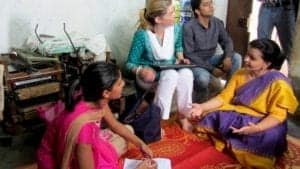No matter how many equal-rights laws a government passes or how hard a financial institution works to draw more women clients, the efforts will face an uphill struggle to reach scale if it is operating in an incompatible context. But all is not lost. If we understand how precisely the social, cultural, legal and economic realities in a particular country impact women’s financial, professional and personal lives, we can create innovative, scalable solutions that result in real, measurable changes for women and move the needle on financial inclusion.
[Tweet “How to identify the most promising levers of change for women’s financial inclusion”]
Women’s World Banking is entering an exciting new strategy and growth phase. We’re building on our existing knowledge base in key markets and introducing a dynamic research approach that will take full measure of the forces at work in women’s lives. Taking a deep dive into the social, cultural, economic and political conditions that affect women in each market will allow us to develop even more targeted solutions that create maximum impact.
Four Lens to Understand Women’s Lives
 This new approach, what we’re calling ‘Market Intelligence,’ looks at women’s experiences along four dimensions. The first encompasses women’s personal agency and societal power, and includes factors such as social norms, legal rights, family dynamics, spending power, risks to safety such as intimate partner violence and comfort with technology. The second focuses on societal and governmental systems, including the social welfare safety net, government mandates, and social support for change. A third dimension examines women’s access to resources, from education, work, health and civic engagement to financial services uptake and usage. The fourth analyzes market and business systems, looking at the resource gaps between men and women, and the organizations shaking up the way the market provides resources and movements that impact women’s lives.
This new approach, what we’re calling ‘Market Intelligence,’ looks at women’s experiences along four dimensions. The first encompasses women’s personal agency and societal power, and includes factors such as social norms, legal rights, family dynamics, spending power, risks to safety such as intimate partner violence and comfort with technology. The second focuses on societal and governmental systems, including the social welfare safety net, government mandates, and social support for change. A third dimension examines women’s access to resources, from education, work, health and civic engagement to financial services uptake and usage. The fourth analyzes market and business systems, looking at the resource gaps between men and women, and the organizations shaking up the way the market provides resources and movements that impact women’s lives.
Applying those lenses to our research t allows us to identify the potential levers for change, and to determine what type of partners; products or services can best impact women’s financial inclusion in that market.
Market Intelligence, India

We specifically looked at Indian women’s approach to savings and the social safety net. India has a strong savings culture, and our research asked how and why Indian women save, as well as which solutions have so far been tested but failed to affect the financial-inclusion gender gap. For instance, Pradhan Mantri Jan Dhan Yojana (PMJDY)—the Prime Minister’s no-frills savings accounts—are designed to bring more unbanked women and men into the formal financial system. Unfortunately, low-income women have barely used them. This is partly because while women in India tend to place a value on savings, they traditionally had limited access to independent financial services. Thus, they typically don’t rely on financial institutions for their savings needs. Low-income Indian women are also still, by and large, not using digital financial services with great frequency.
Opportunities Based on Research
There are many opportunities for us, along with our partners, to leverage financial education and affect the social norms and institutions preventing women from accessing financial services. Our work in India is looking at potential ways in which we can use the no-frills accounts beyond a place to receive their government benefits. It can be a first step to bring more women into the formal financial system and help them grow their assets and achieve greater financial security and empowerment. We also believe financial institutions in India could be much more effective if they looked at women more directly and valued them as individual clients within the financial system, instead of focusing on women primarily within the space of microcredit or group loans.
These are a few of the questions we will be focusing on as we work with our partners to create lasting solutions: What constitutes a safety net for women in India? What does it take to get Indian women to use the no-frills savings accounts to build that safety net and develop their assets? What are the main obstacles to uptake and engagement with digital financial services? How can we engage our various partners in achieving that goal and making a dent in financial inclusion? What do we see as the real gaps in that environment?
This approach, as we have seen in our India work, is bringing the challenges, opportunities and solutions into sharper focus. We’re looking ahead to the findings from our current or upcoming research projects in key markets such as Pakistan, Egypt and Colombia. Much in-depth work lies in front of us. We’re looking forward to the fresh insights and perspectives to come in 2017 and beyond.



